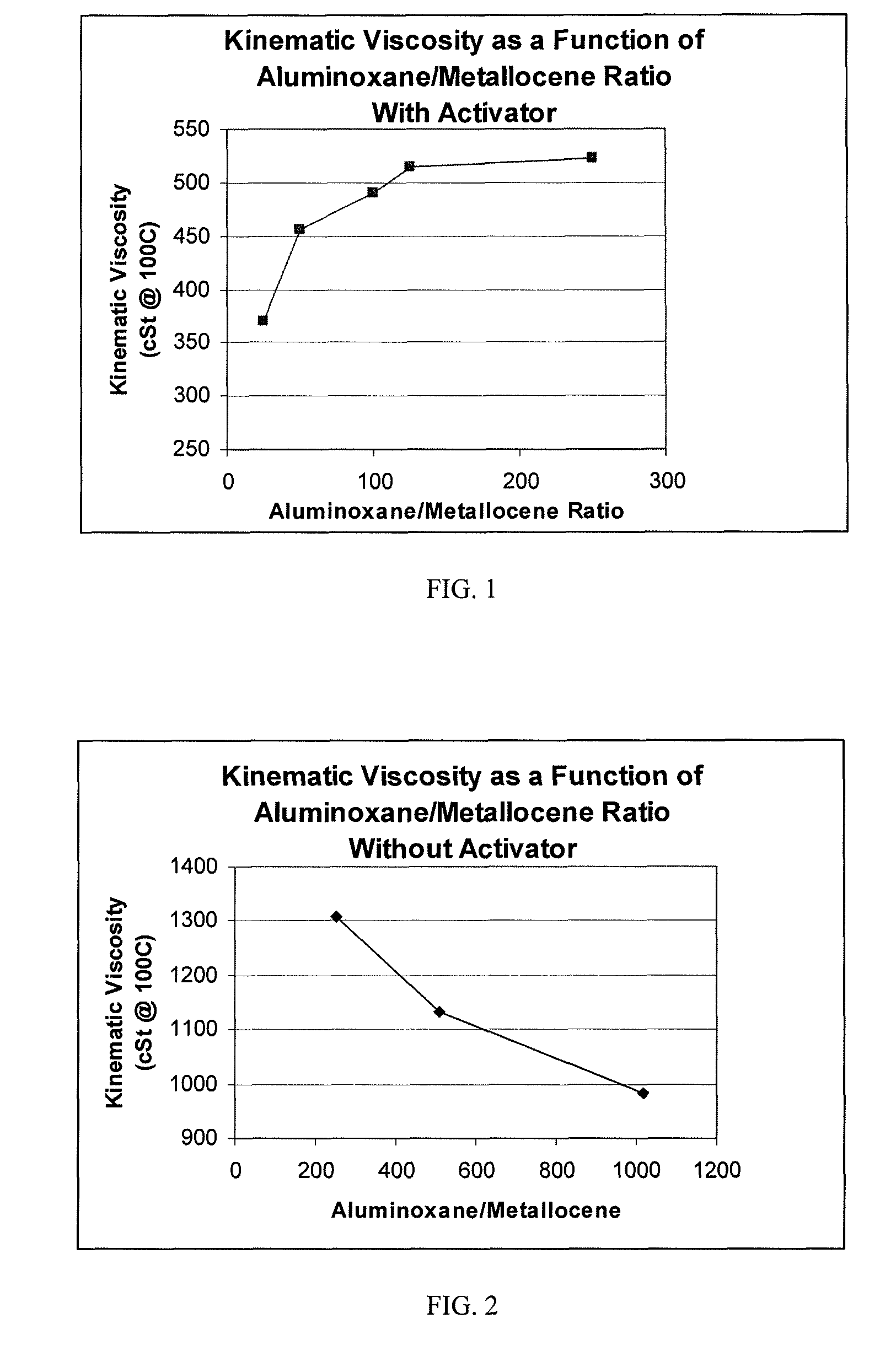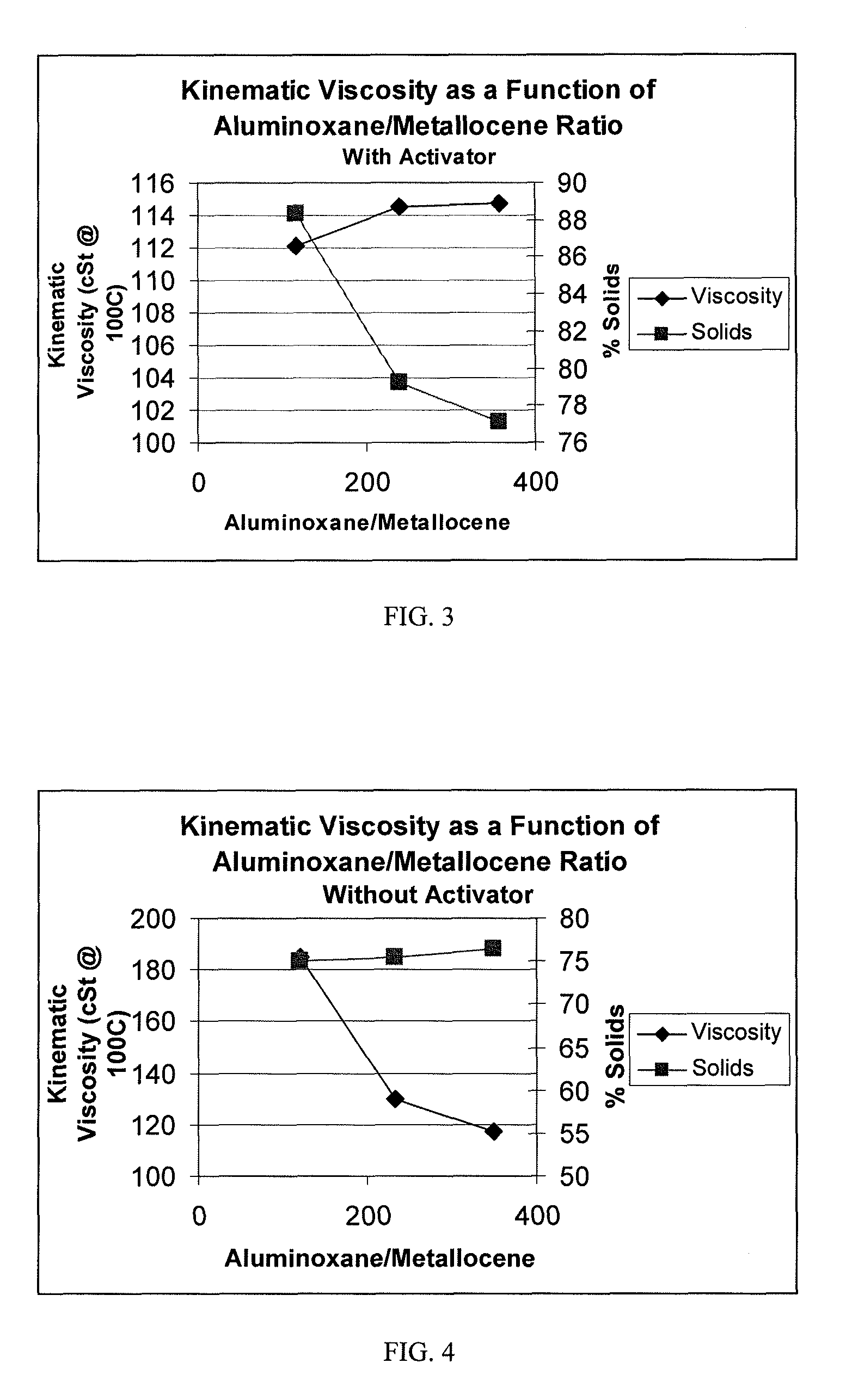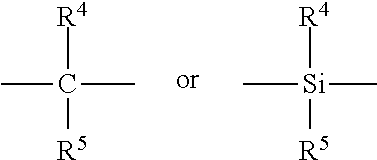Processes for controlling the viscosity of polyalphaolefins
a technology of polyalphaolefin and viscosity, which is applied in the field of preparation of polyalphaolefin, to achieve the effects of reducing the molar ratio of aluminoxane cocatalyst, good viscometric properties, and careful control of the viscosity of pao polymers
- Summary
- Abstract
- Description
- Claims
- Application Information
AI Technical Summary
Benefits of technology
Problems solved by technology
Method used
Image
Examples
example 1
Comparative
[0054]In a glove box, 0.02 grams of diphenylmethylene(cyclopentadienyl)(9-fluorenyl) zirconium dichloride (hereinafter Ph2C(Cp-9-Flu)ZrCl2) was weighed out into a 25 ml vial. 12 ml of 1.5M MAO solution was added and the mixture dissolved using a shaker for at least 10 minutes at room temperature.
[0055]A moisture and air free 3 liter Buchi reactor was charged with 670 grams of dry 1-decene monomer. The reactor was purged with nitrogen. The reactor was brought to a temperature of 90° C. The reactor was vented to near zero pressure. Hydrogen was added to bring the reactor pressure to 50 psig (345 kPag). Using a dry 5 ml syringe and needle, 5 ml of catalyst solution was added to the reactor. With 550 rpm of agitation, the reaction was allowed to proceed for 30 minutes. The reactor was vented and purged with nitrogen and the product allowed to cool to a safe temperature for removal.
[0056]The reactor contents were then transferred to a vessel equipped with an agitator and 13.4 ...
examples 2-6
[0057]Examples 2-6 were performed in the same manner as Example 1 except that borate was added on an equal molar basis (0.0288 grams of dimethylaniliniumtetrakis (pentafluorophenyl)borate) to the Ph2C(Cp-9-Flu)ZrCl2, and the MAO (reduced as described in Table 1 with toluene being substituted for the balance).
[0058]
TABLE 1RUN#123456DescriptionPAOPAOPAOPAOPAOPAOPolymerization Temperature: (° C.)909090909090Polymerization Time: (Minutes)303030303030Co-Catalyst TypeMAOMAOMAOMAOMAOMAOWeight %: 10% (1.5M) mL12 [1.05 gr]6 [0.52 gr]3 [0.26 gr]2.4 [0.21 gr]1.2 [0.105 gr]0.6 [0.0525 gr][cocatalyst amount]H2 100% psig (kPag)50 (345)50 (345)50 (345)50 (345)50 (345)50 (345)Catalyst Activator Type:noneBorateBorateBorateBorateBorateActivator: (grams)00.02880.02880.02880.02880.0288Agitator Speed, rpm550550550550550550Decene, grams670670670670670670Co-Catalyst:Catalyst Ratio, MAO:Zr500:1250:1125:1100:150:125:1Activator:Catalyst Ratio, Borate:Zr 0:1 1:1 1:1 1:1 1:1 1:1Catalyst Concentration (M)0.0030...
examples a-c
Comparative
[0061]A dried 3 liter Buchi reactor was filled under argon with 750 ml of dry 1-decene monomer. To this, 1.15 ml of a 25% by wt. solution of triisobutylaluminum in hexane was added to scavenge moisture and impurities, and the reactor temperature was brought up to 70° C. Once the temperature reached 70° C., 1 mole of hydrogen gas was added to the reactor via pressure drop from a vessel of known volume. Then, a solution of 0.007 g of Ph2C(Cp-9-Flu)ZrCl2 was dissolved in a 10 wt. % solution of MAO in toluene to obtain MAO to catalyst ratios of 250:1 to 1000:1 with 0.44 mmole of triisobutylaluminum. The catalyst solution was prepared 30 minutes prior to its use, and was injected into the stirring reactor under 200 psig (1379 kPag) argon pressure. The reactor was maintained at a temperature of 70° C. and 200 psig (1379 kPag) for a period of 30 minutes.
[0062]When complete, the reactor was depressurized and 400 ml hexane was added to the polymerized decene solution to aid in tra...
PUM
| Property | Measurement | Unit |
|---|---|---|
| kinematic viscosity | aaaaa | aaaaa |
| kinematic viscosity | aaaaa | aaaaa |
| kinematic viscosity | aaaaa | aaaaa |
Abstract
Description
Claims
Application Information
 Login to View More
Login to View More - R&D
- Intellectual Property
- Life Sciences
- Materials
- Tech Scout
- Unparalleled Data Quality
- Higher Quality Content
- 60% Fewer Hallucinations
Browse by: Latest US Patents, China's latest patents, Technical Efficacy Thesaurus, Application Domain, Technology Topic, Popular Technical Reports.
© 2025 PatSnap. All rights reserved.Legal|Privacy policy|Modern Slavery Act Transparency Statement|Sitemap|About US| Contact US: help@patsnap.com



